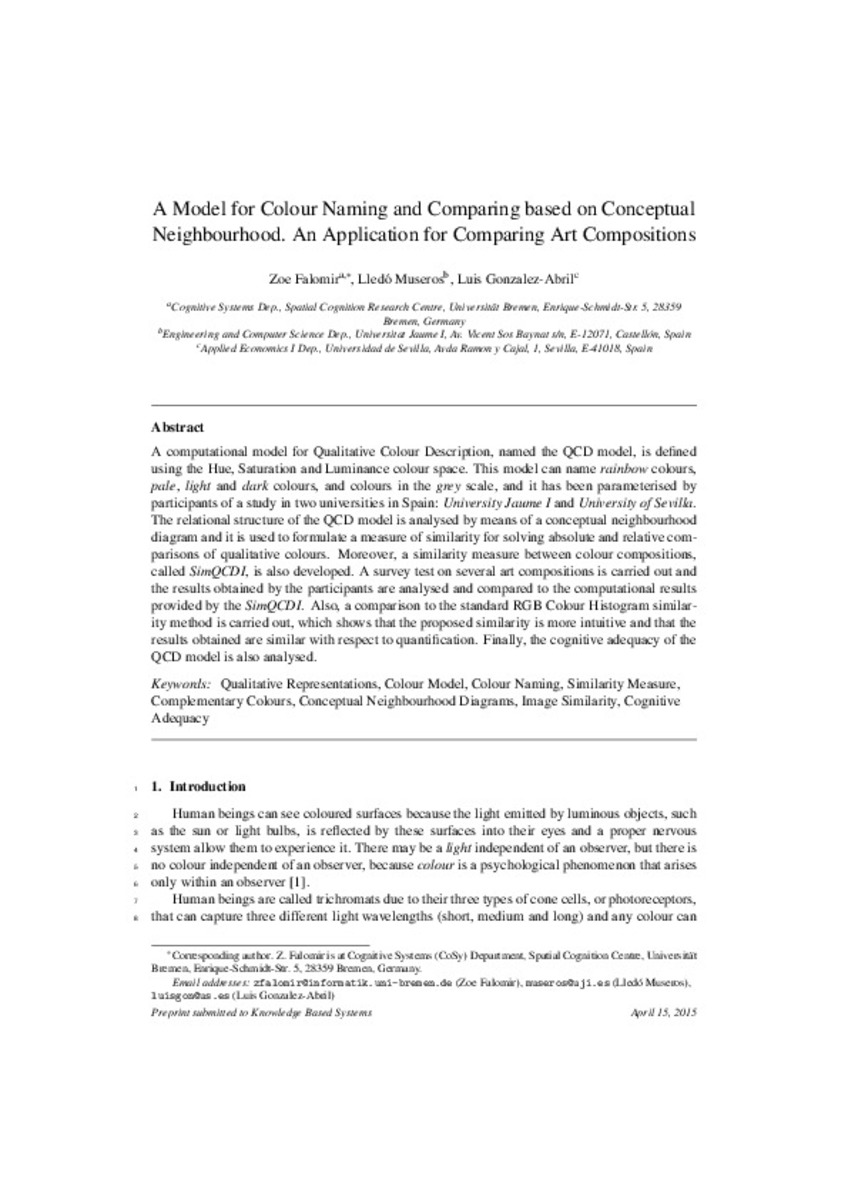Mostrar el registro sencillo del ítem
A model for colour naming and comparing based on conceptual neighbourhood. An application for comparing art compositions
| dc.contributor.author | Falomir, Zoe | |
| dc.contributor.author | Museros, Lledó | |
| dc.contributor.author | Gonzalez Abril, Luis | |
| dc.date.accessioned | 2016-02-24T08:52:52Z | |
| dc.date.available | 2016-02-24T08:52:52Z | |
| dc.date.issued | 2015 | |
| dc.identifier.citation | FALOMIR, Zoe; MUSEROS, Lledó; GONZALEZ-ABRIL, Luis. A model for colour naming and comparing based on conceptual neighbourhood. an application for comparing art compositions. Knowledge-Based Systems, 2015, vol. 81, p. 1-21. | ca_CA |
| dc.identifier.issn | 0950-7051 | |
| dc.identifier.issn | 1872-7409 | |
| dc.identifier.uri | http://hdl.handle.net/10234/151529 | |
| dc.description.abstract | A computational model for Qualitative Colour Description, named the QCD model, is defined using the Hue, Saturation and Luminance colour space. This model can name rainbow colours, pale, light and dark colours, and colours in the grey scale, and it has been parameterised by participants of a study in two universities in Spain: University Jaume I and University of Sevilla. The relational structure of the QCD model is analysed by means of a conceptual neighbourhood diagram and it is used to formulate a measure of similarity for solving absolute and relative comparisons of qualitative colours. Moreover, a similarity measure between colour compositions, called SimQCDI, is also developed. A survey test on several art compositions is carried out and the results obtained by the participants are analysed and compared to the computational results provided by the SimQCDI. Also, a comparison to the standard RGB Colour Histogram similarity method is carried out, which shows that the proposed similarity is more intuitive and that the results obtained are similar with respect to quantification. Finally, the cognitive adequacy of the QCD model is also analysed. | ca_CA |
| dc.description.sponsorShip | This work was supported by European Commission through FP7 Marie Curie IEF actions under project COGNITIVE-AMI https://sites.google.com/site/zfalomir/projects/cognitive-ami (GA 328763), the Research Centre on Spatial Cognition at the University of Bremen, the Deutscher Akademischer Austausch Dienst (DAAD), Andalusian Regional Ministry of Economy (project SIMON TIc-8052), Spanish Ministry of Economy and Competitiveness (project TIN2011-24147), Generalitat Valenciana (project GVA/2013/135) and Universitat Jaume I (Project P11B2013-29). | ca_CA |
| dc.format.extent | 21 p. | ca_CA |
| dc.format.mimetype | application/pdf | ca_CA |
| dc.language.iso | eng | ca_CA |
| dc.publisher | Elsevier | ca_CA |
| dc.relation.isFormatOf | Versió pre-print del document publicat a: http://www.sciencedirect.com/science/article/pii/S0950705114004511 | ca_CA |
| dc.relation.isPartOf | Knowledge-Based Systems, 2015, vol. 81 | ca_CA |
| dc.rights | Copyright © Elsevier | ca_CA |
| dc.rights.uri | http://rightsstatements.org/vocab/InC/1.0/ | * |
| dc.subject | qualitative representations | ca_CA |
| dc.subject | colour model | ca_CA |
| dc.subject | colour naming | ca_CA |
| dc.subject | similarity measure | ca_CA |
| dc.subject | complementary colours | ca_CA |
| dc.subject | conceptual neighbourhood diagrams | ca_CA |
| dc.subject | image similarity | ca_CA |
| dc.subject | cognitive adequacy | ca_CA |
| dc.title | A model for colour naming and comparing based on conceptual neighbourhood. An application for comparing art compositions | ca_CA |
| dc.type | info:eu-repo/semantics/article | ca_CA |
| dc.identifier.doi | http://dx.doi.org/10.1016/j.knosys.2014.12.013 | |
| dc.rights.accessRights | info:eu-repo/semantics/openAccess | ca_CA |
| dc.relation.publisherVersion | http://www.sciencedirect.com/science/article/pii/S0950705114004511 | ca_CA |
Ficheros en el ítem
Este ítem aparece en la(s) siguiente(s) colección(ones)
-
ICC_Articles [417]







